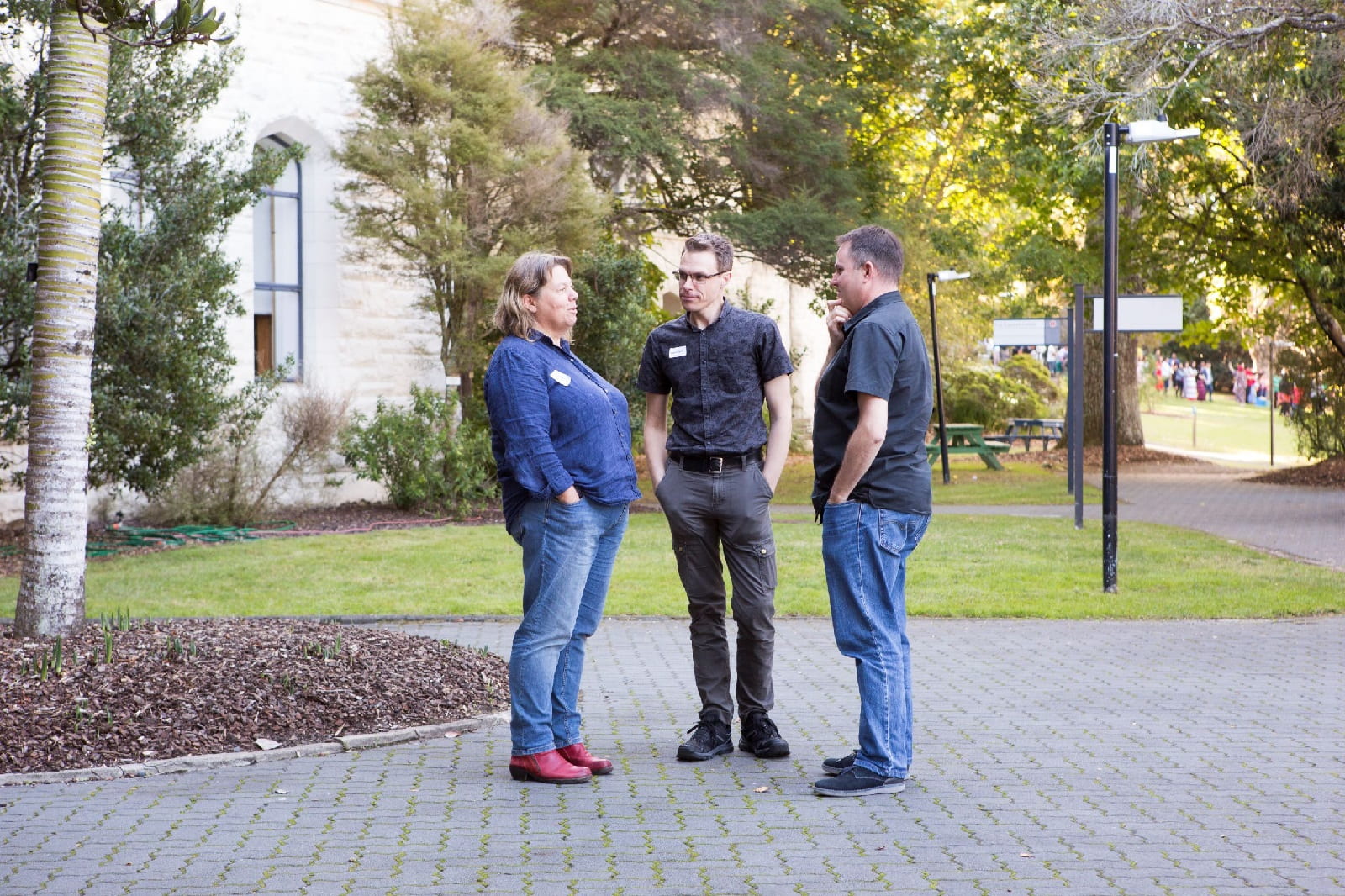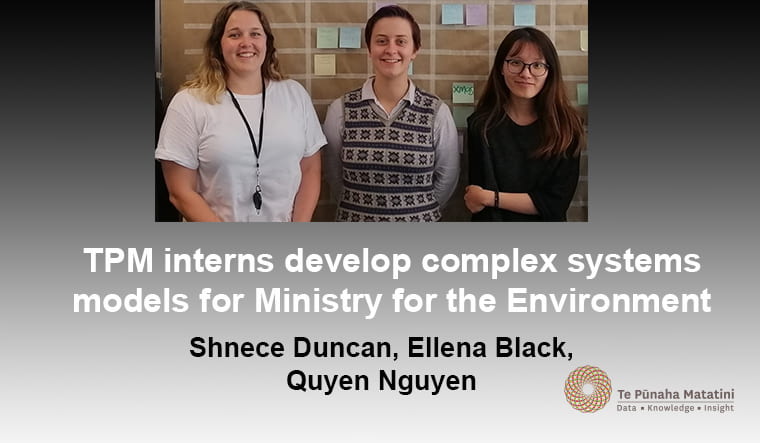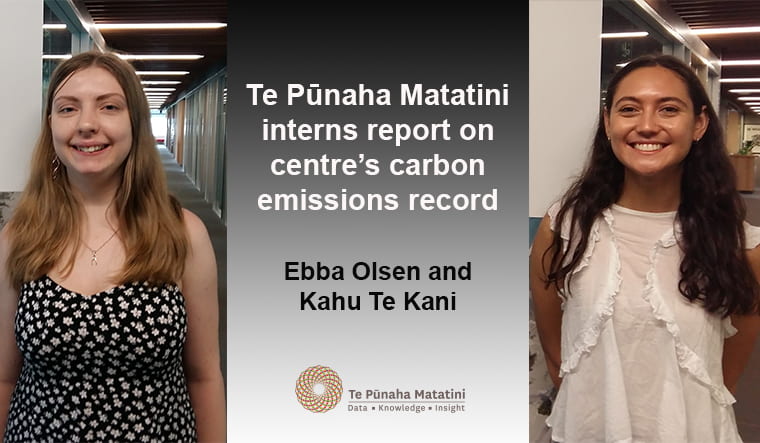Out and about
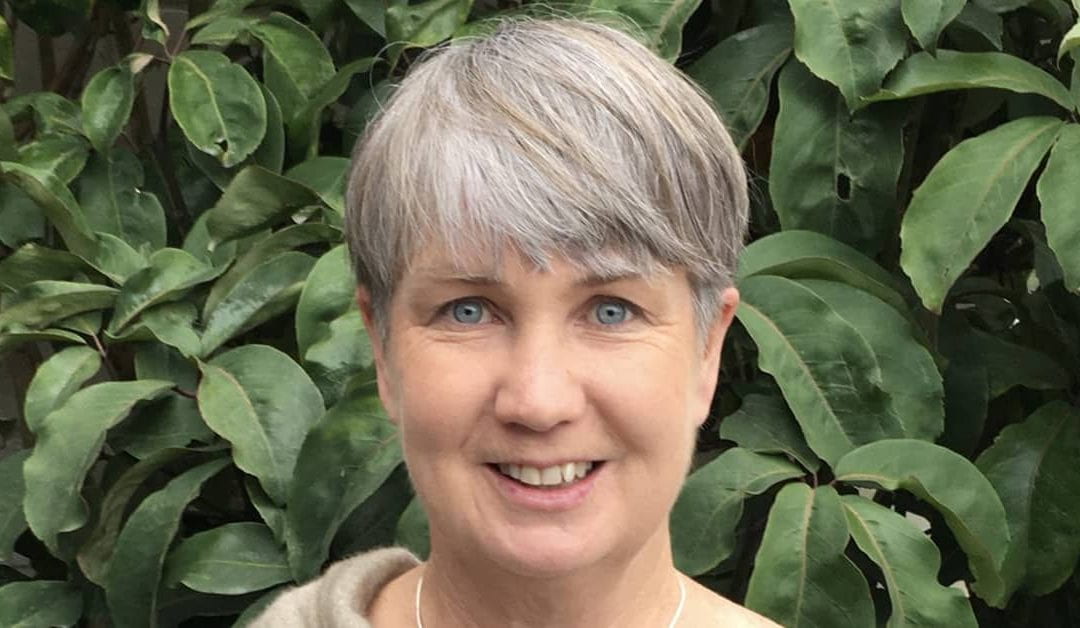
Dr Andrea Byrom honoured to accept new role as kairangi
Ecologist and science leader Dr Andrea Byrom has accepted a role as kairangi in Te Pūnaha Matatini.
Kairangi is a Māori word meaning ‘the finest pounamu’, which can be used to describe a person held in high esteem. This role acknowledges the important contributions of our senior colleagues.
Dr Andrea Byrom has been involved with Te Pūnaha Matatini as an associate investigator since the early days, and has contributed at many hui and supervised several early career researchers. She is currently co-supervising Te Pūnaha Matatini Whānau member Julie Mugford in the final stages of her thesis, alongside Associate Professor Alex James and Professor Michael Plank.
The project that Andrea is most proud of being involved with at Te Pūnaha Matatini was exploring the biodiversity benefits of large-scale pest control regimes with Dr Rachelle Binny. Their work quantified significant benefits for biodiversity from pest control over two decades. Andrea says that “I’m proud to have contributed to that research because it really demonstrated how important science is to the environment, and why we do large-scale conservation efforts like pest control or ecological restoration.”
She also particularly enjoyed collaborating with Professor Shaun Hendy and a group of summer interns on network analyses of the many types of people and organisations involved in environmental protection in Aotearoa. “That was a real introduction to network analyses and some of the things Te Pūnaha Matatini had to offer that I had not previously thought of applying to te taiao the environment.”
Andrea recently resigned from her role as director of Ngā Koiora Tuku Iho New Zealand’s Biological Heritage National Science Challenge. She has been working in the New Zealand science system since joining Manaaki Whenua Landcare Research as a postdoctoral researcher in 1997.
Over two decades working at Manaaki Whenua Andrea moved away from directly doing her own research and into leadership roles, after becoming interested in how science leadership could empower scientists to do their work, rather than add more bureaucracy to their lives.
She says that she “really loved that leadership style”.
“What I liked most about being a director of a National Science Challenge was having a view across all of the amazing talent that we have in the New Zealand science system.”
Her directorial responsibilities meant that Andrea did not have as much time as she would like to devote to Te Pūnaha Matatini in recent years. “I’ve been on a separate journey from Te Pūnaha Matatini for the last wee while, so to come back in as a kairangi now is quite an honour.”
“In the last few years, my interests have broadened to thinking about how we take our Te Tiriti o Waitangi partnership role seriously as scientists, and how we bring mātauranga Māori and kaupapa Māori research methods to the fore. I worked hard to facilitate a lot of that via the National Science Challenge and ended up in a co-director role in that area with Melanie Mark-Shadbolt.”
“I feel like the tide’s turning and that people are starting to listen. But it’s really important to put different perspectives and stories out there.”
After a demanding period as a director, Andrea is focusing on spending more time with her partner, as well as doing environment consultancy work and board roles. “I’m particularly interested in how important governance is to science and the environment. That’s my new passion, and as a kairangi I would like to contribute where I can – particularly around complex environmental research.”
“I love being a sounding board for students and I love coming to hui where there are great minds contributing things that I hadn’t thought of and ideas that I’m interested in.”
Since stepping back as a director, Andrea and her partner have been making the most of their time together by killing of a large amount of lawn on their half-hectare property in mid-Canterbury and replanting it with over 5,000 native plants.
How to kill your lawn with Andrea Byrom
- Acquire large quantities of cardboard boxes and flatten them
- Lay cardboard over lawn on non-windy day
- Cover cardboard with a whole lot of mulch
- Water it all down
- Leave for two months
- Replant with native plants
Links
• Long-term biodiversity trajectories for pest-managed ecological restorations: eradication vs. suppression – Ecological Monographs
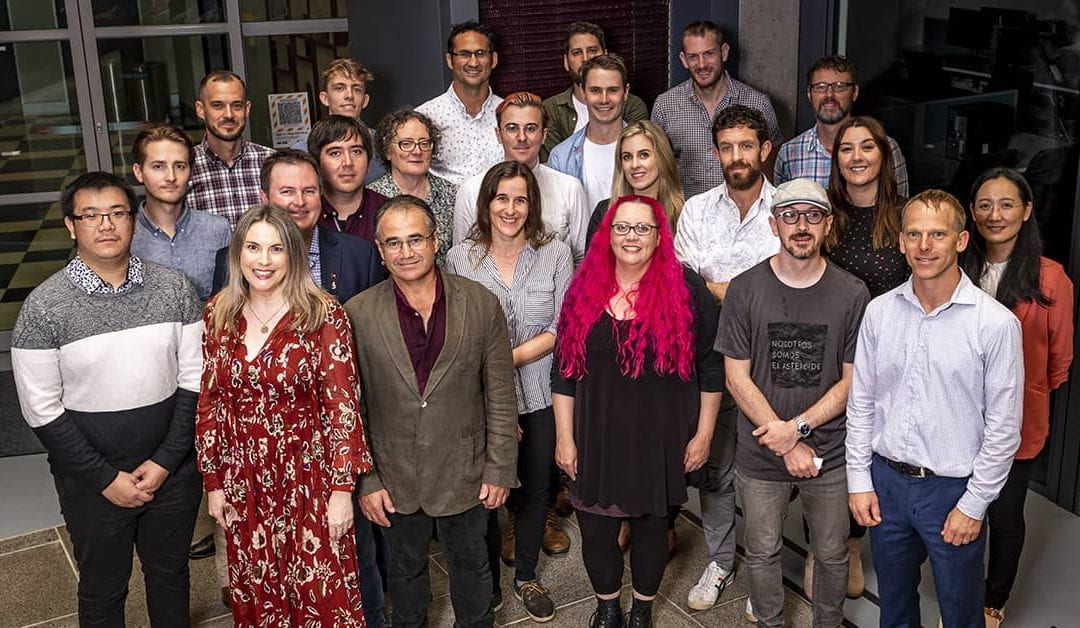
Prime Minister recognises transformative science
13 April 2021
The 2020 Prime Minister’s Science Prize has been awarded to Te Pūnaha Matatini for our contribution to Aotearoa New Zealand’s Covid-19 response.
The Prime Minister’s Science Prize is awarded for transformative science which has had a significant economic, health, social or environmental impact.
Te Pūnaha Matatini are being recognised for our work that developed a series of mathematical models, analysed data and communicated the results to inform the New Zealand Government’s world-leading response to the global pandemic.
Te Pūnaha Matatini is a Centre of Research Excellence funded by the Tertiary Education Commission and hosted by the University of Auckland. Over the past six years, Te Pūnaha Matatini has grown from the kernel of an idea into a diverse national network of over a hundred investigators and students who are tackling the interconnected and deeply interdisciplinary challenges of our time. Our values, expertise and focus on communication made us uniquely positioned to grapple with the Covid-19 pandemic in Aotearoa New Zealand.
Te Pūnaha Matatini’s modelling was key in helping the government make good decisions about lockdowns, particularly in April and May when the need to relax Alert Levels arrived, and in August, when a tailored lockdown was used in Auckland to eliminate a large outbreak. These public health interventions have had an immense impact on New Zealanders’ lives, not the least of which was preventing a considerable number of deaths due to Covid-19 if the virus had been allowed to spread unimpeded.
“Even I underestimated the centrality of [science] advice for me, in this time in office, and just how important it would become to us as a government.” – Jacinda Ardern, Prime Minister of New Zealand
The team made sure their models served the health system by working with Orion Health data scientists to ensure information got to where it was needed. Orion Health works with healthcare sector clients to deploy and manage machine learning models, which meant they were able to offer their technology and processes to support the Te Pūnaha Matatini team.
Te Pūnaha Matatini’s work and related research from around the globe was actively communicated to the public throughout 2020, and several of Te Pūnaha Matatini’s researchers were the most prominent science communicators during the crisis.
“I want to thank the many, many, many people in this room who were a part in your own ways in either helping us generate the information we needed to make those decisions, or who helped us communicate those decisions when it mattered most.” – Jacinda Ardern, Prime Minister of New Zealand
The transdisciplinary team working on Covid-19 that received this award brought together researchers from the University of Auckland, University of Canterbury, Victoria University of Wellington, Manaaki Whenua Landcare Research, Market Economics, and Orion Health.
The Covid-19 programme that arose under the leadership of Te Pūnaha Matatini investigators in 2020 continues into 2021 as two independent projects: Covid-19 Modelling Aotearoa and The Disinformation Project.
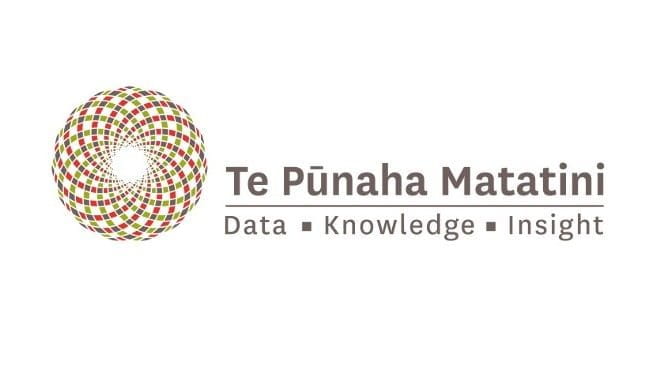
Te Pūnaha Matatini secures future with CoRE funding to 2028
Te Pūnaha Matatini has been successful in its bid to be refunded by the New Zealand Government’s Tertiary Education Commission (TEC) in the recent CoRE round. From 1 July 2021, the Centre’s funding will rise from $2.1 million per annum to $4 million per annum through to the end of 2028. In its announcement, the TEC singled out Te Pūnaha Matatini’s contribution to the COVID-19 response through its modelling of infection spread.
Te Pūnaha Matatini incoming co-directors Priscilla (Cilla) Wehi, a Conservation Biologist with Manaaki Whenua Landcare, and Murray Cox, a Professor of Computational Biology at Massey University, were delighted to hear the news.
“It is amazing to be leading such a strong cohort of researchers who can cross disciplines and address the complexity of systems,” said Cilla. “These ways of thinking will provide real traction in addressing some of the huge problems we are facing globally, and stimulate innovation.”
“We’ve have a lot of impact on New Zealand over the last six years and we’re really looking forward to delivering even more over the next eight,” added Murray.
Director Shaun Hendy, Professor of Physics at the University of Auckland, who has led Te Pūnaha Matatini from its inception in 2013, said the successful rebid was underpinned by a massive team effort.
“[It’s] the culmination of eighteen months of enormously hard work by Kate Hannah, Cilla Wehi, Murray Cox, Kathryn Morgan, and many others,” said Shaun. “It also reflects the commitment of all our investigators, our Whānau, and our friends to Te Pūnaha Matatini’s mission over the last seven years. Congratulations and commiserations to the other applicants, who have also worked hard over the last year or more.”
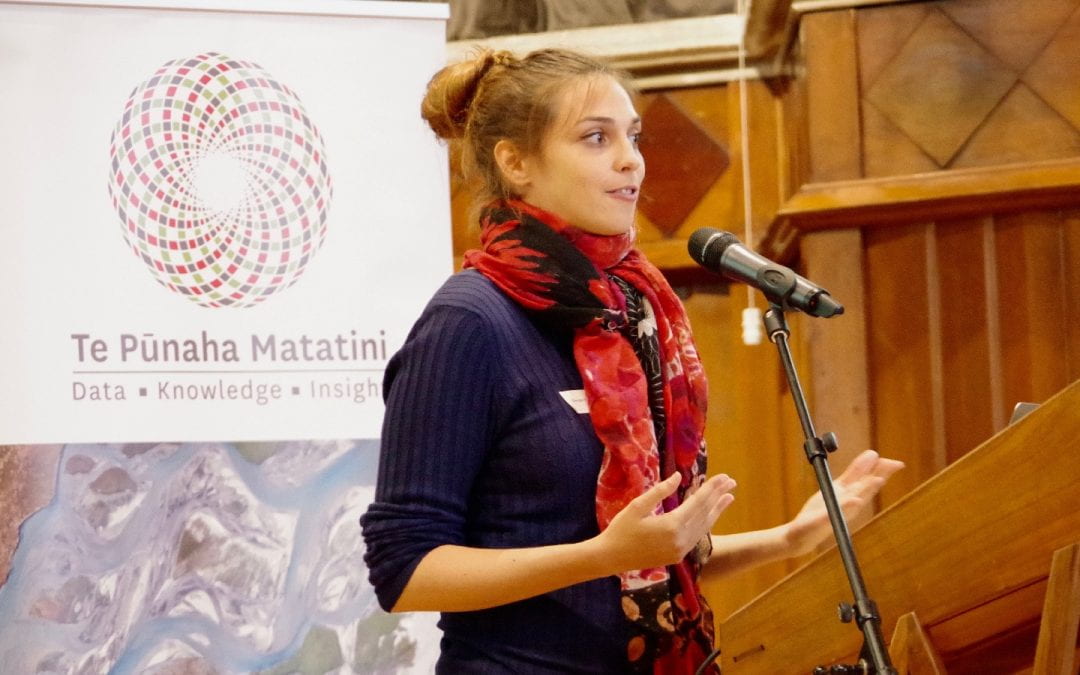
How differing animal personalities impact on conservation efforts
Te Pūnaha Matatini researcher Giorgia Vattiato (above) and colleagues, from the School of Mathematics and Statistics at the University of Canterbury, are modelling the effects of individual animal personalities in New Zealand on conservation efforts. The purpose – to answer questions such as why some invasive mammal pests always manage to avoid traps, and what kind of reintroduction measures for Kiwi might help them settle more efficiently.
Enhancing the efficiency of invasive mammal pest trapping
Invasive mammal pests such as stoats, possums and rats represent a major threat to New Zealand’s native birds such as Kiwi. Trapping pests as part of wider eradication efforts has worked well on small offshore islands and fenced-off areas of the mainland. However, a few individual animals always seem to be uncatchable – an issue that has led to a growing need for more robust eradication approaches.
Giorgia’s research looks beyond what we already know about factors that influence the behaviour of animal populations. It is well known, for example, that differences in habitat, predation, food availability, social environment and physiology can all affect animal behaviours (and personalities). Common personality differences include boldness or shyness, activity level, resource selection, sociability, and home range size. These different personalities can affect a population as a whole, but very few population dynamic modelling studies have taken them into consideration.
The study of animal personalities can therefore be seen as an important step towards developing accurate, non-biased models that can better predict the efficiency of different programmes underway in New Zealand that aim to eradicate pests, reintroduce threatened species and protect biodiversity.
This has been the rationale of Giorgia’s research – modelling the effects of individual animal personalities in New Zealand. Together with her Te Pūnaha Matatini supervisors, Dr Rachelle Binny at Manaaki Whenua Landcare Research, Associate Professor Alex James and Professor Michael Plank at the University of Canterbury, plus Associate Professor Isabel Castro at Massey University, she has conducted two different types of projects as part of her PhD study.
The first project involves modelling different scenarios of heterogeneity in a pest population, where individual animals are assigned a different probability of interacting with a newly-found trap (their ‘trapability’). Running simulations of two different pest populations – homogenous (all individuals had the same trapability) and heterogenous (individuals have varying levels of trapability), revealed that it takes much longer to eradicate the latter population than the former.
“One of the outputs of our model is the time that you need to wait to be sure that your population has been completely eradicated,” explained Giorgia. “Usually what a pest manager would do is wait until a number of consecutive nights when there have been no captures. After a certain number of nights, they would say ‘okay, we’re 95% sure that we’ve eradicated the population.’ So what we’ve done is simulated this number of nights to have 95% probability of eradication in different scenarios, and we’ve looked at how long we have to wait. So this is one way our model can be used.”
“The model can be used to predict when to change eradication approaches. At one point the curves start to flatten and tail off as those last few very trap-shy individuals keep evading capture. So the flattening curve could inform a pest manager when to switch to a more intensive eradication mode – one that may be more expensive than the first part of the eradication.”
Different Kiwi behave and react differently in response to being moved
The second project the team are working on aims to identify possible differences in the behaviour of Kiwi populations on Motuarohia Island in the Bay of Islands and Ponui Island in the Hauraki Gulf. One of Giorgia’s supervisors on this project, Isabel Castro, had acquired data from previous years when capturing and recording information about the Kiwi population on Ponui Island.
“Isabel could see how different the birds were – some were very friendly, some were not,” said Giorgia. “But nobody had actually ever looked at the numbers behind that. And so I went with her this year and we did a few experiments. We filmed the Kiwi right after capture, under different circumstances – holding them upside down, looking at them in the eye, whilst also recording their heart beat and respiratory rate, to look for differences between birds. They were so different. Some of them would just fall asleep in your arms, and others would never stop struggling. Some of them would even growl or snap their beak.”
Their findings, yet to be published, are expected to be useful for guiding relocation efforts. “Just knowing that the birds have different personalities is something that conservation managers will want to know, especially for situations such as translocations of birds,” explained Giorgia.
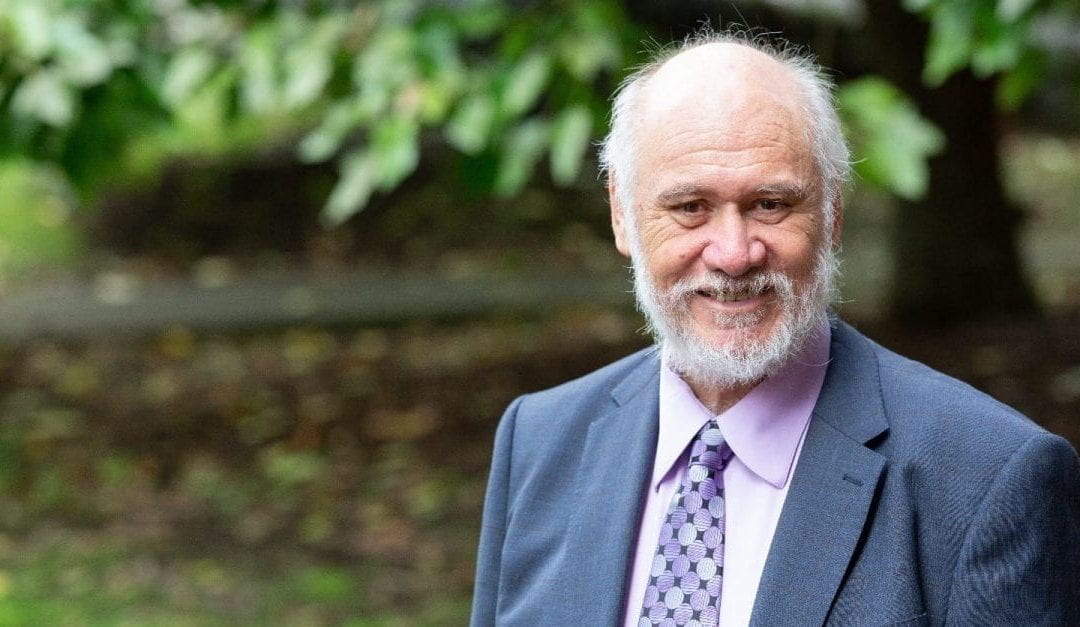
Introducing Tom Roa, inaugural kaumātua for Te Pūnaha Matatini
A hui held at the University of Auckland on 2 July 2019 marked a special moment in the history of Te Pūnaha Matatini – the inauguration of our first ever kaumātua Dr Tom Roa (Ngāti Maniapoto, Waikato).
Dr Tom Roa, a Tainui leader and Manukura / Associate Professor in the University of Waikato’s Faculty of Māori and Indigenous Studies, is a familiar figure on marae throughout Tainui and the country. Over the years, Tom has also been a leading figure helping to bring the Māori language into the mainstream, and he is one of the founders of Te Wiki o Te Reo Māori movement in the 1970s.
Tom’s appointment as Te Pūnaha Matatini kaumātua enables us to continue to grow a safe and inclusive CoRE for our multicultural team of investigators and students, and maintains our leadership in this particular area within the Aotearoa New Zealand science and research system.
The July hui at the University of Auckland comprised a large gathering of Te Pūnaha Matatini investigators, friends and Whānau from all over New Zealand.
Following a warm mihi whakatau, Te Pūnaha Matatini Incoming Co-Director Cilla Wehi shared stories about her work with Tom over the years and provided some personal insights.
“Matua Tom has a very long research career in linguistics and translation,” said Cilla. “More than that even, he is valued for his immense skills in the Māori world as somebody who has incredible expertise in whaikōrero, in the art of oratory, but who can also cut to the point in a very pithy way.”
Cilla then welcomed Tom to the stage for his keynote speech – ‘He Puna Pūnaha’ – a springboard for ideas in the myriad of theories and systems to be explored.
Tom’s talk was inspiring and it was a privilege to hear him speak. He talked about key concepts and traditions central to mātauranga in a way that his audience, many of whom are relative newcomers to Aotearoa, appreciated immensely. Tom also shared a karakia, a prayer invoking spiritual guidance.
“I have a fascination with how mātauranga Māori and science can be woven together. So TPM fascinates me even more because of the interdisciplinary nature of so many of the projects that I’ve had a glance through,” said Tom.
“When Potatau, the first Māori King was anointed, he said ‘there is but one eye of the needle through which must pass the red, the black and the white threads’. Many people have taken that to mean that it’s about bringing people together,” said Tom. “But for TPM, I suggest that you might have a mathematical thread, somebody else might have an ecological thread, somebody might have an economic thread.
“Somebody might have all of these different kinds of threads, along with my Māori thread,” said Tom. “And if we thread those through the eye of the needle, they become something else. They become interweaved, and my suggestion is that if we thread that eye of the needle and if we bring all of that together properly, then we have a new creation – new data, new knowledges, new insights. Through that weaving.”
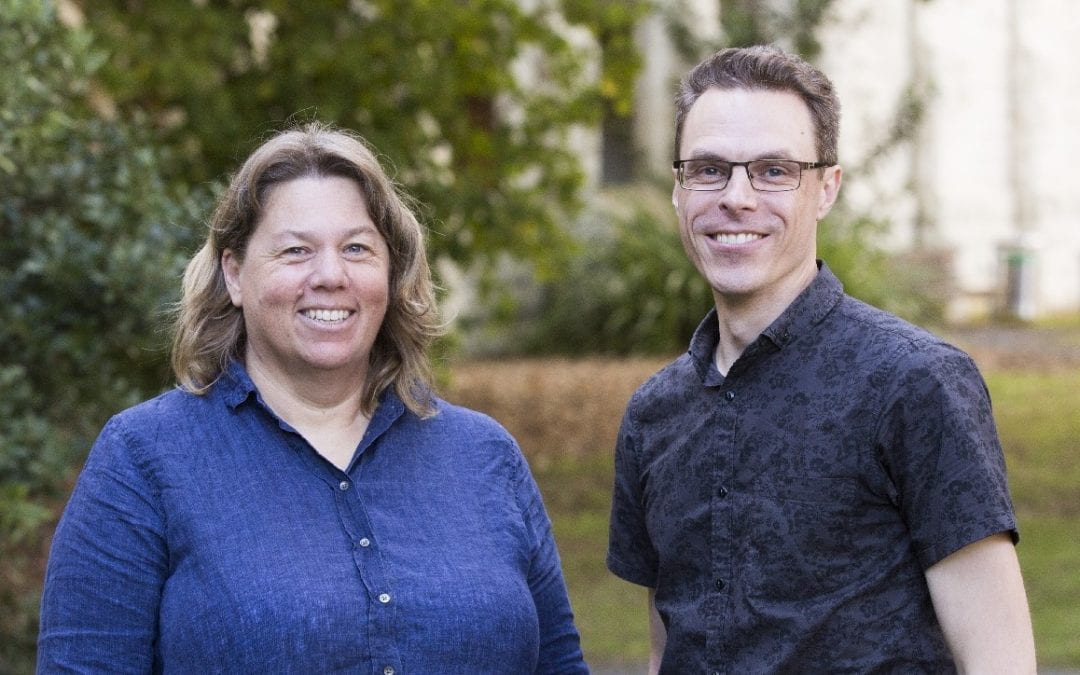
Researching impact of Moa extinctions on early Māori
Te Pūnaha Matatini incoming co-directors Priscilla (Cilla) Wehi and Murray Cox have collaborated with Hēmi Whaanga and Te Pūnaha Matatini Kaumātua Tom Roa, from the Faculty of Māori and Indigenous Studies at the University of Waikato, on an analysis of Māori ancestral sayings (whakataukī), and their recognition of extinctions and their impact.
Cilla, a conservation biologist with Manaaki Whenua Landcare, and Murray, a Professor of Computational Biology at Massey University, co-authored a paper published in the journal Human Ecology, reporting the linguistic analysis of indigenous Māori whakataukī that focus on fauna and environment, particularly with regard to extinctions of important food sources such as Moa. The findings provide evidence that such extinctions were important as they influenced both ecological and social thought in Māori society. The authors also suggest that oral traditions could have played a similar role in other early societies living through major faunal extinction events.
Examples of whakataukī referring to Moa extinction:
Kua ngaro i te ngaro o te moa
Lost as the moa was lost
Huna i te huna a te moa
Hidden as the moa hid
Ka ngaro ā-moa te iwi nei
The people will disappear like the moa
“Oral tradition, such as these whakataukī passed down by Māori, provide our only real glimpses into the ecological relationships and concerns of early settler populations, and provide early human context to an otherwise relatively dry scientific record of extinction events,” the researchers wrote.
“The whakataukī emphasise that indigenous peoples are not simply passive actors against an environmental backdrop but rather interact with the environment in myriad ways that affect not only the species assemblages present but also the development of cultural values, ideas, and practices.”
Cilla and Murray’s work was picked up by The Conversation in an article entitled ‘Dead as a moa: oral traditions show that early Māori recognised extinction’, and in interviews on Radio NZ, Radio Waatea and TVNZ’s Te Karere.
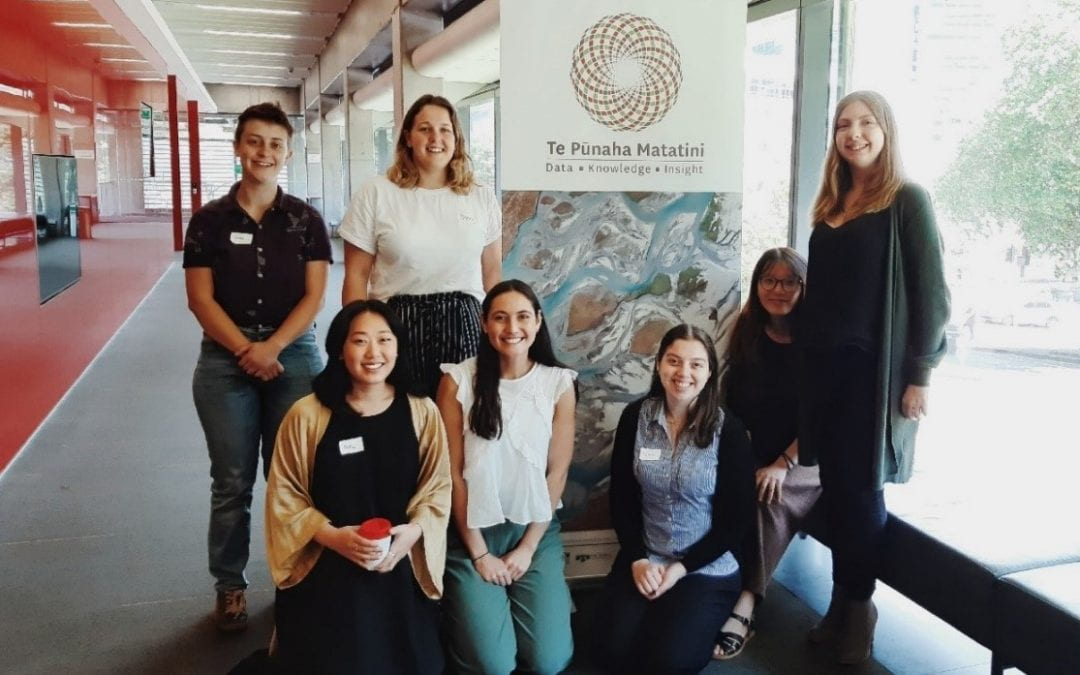
Young achievers: Our 2019-20 student summer interns
Several New Zealand university students took up the opportunity to join Te Pūnaha Matatini’s 2019-20 summer internship programme, with paid 10-week placements working on research projects with a variety of our partner organisations.
Once again, our student interns had a range of backgrounds and came from all parts of the country, but they all shared a common desire to make the world a better place through the application and analysis of data, while gaining on-the-job experience.
“This programme is now its fifth year of operation and each year we have had an amazing group of students take up some fantastic opportunities with our partners,” said Kathryn Morgan, Research Operations Coordinator at Te Pūnaha Matatini. “The core objectives remain the same as previous years – providing students with invaluable data analytics experience and insights into working for organisations in the real world.”
The 2019-20 programme featured some very interesting projects involving a mix of both public and private sector work. Here we profile a few of the projects our interns worked on:
Developing complex systems models – Ministry for the Environment
A team of three interns in our programme were placed with the Ministry for the Environment (MfE) where they piloted a complex systems approach to modelling policy problems.
Shnece Duncan, a University of Canterbury Master of Commerce in Economics student, Ellena Black, a University of Auckland Honours degree graduate in Applied Mathematics, and Quyen Nguyen, a University of Otago Finance PhD student, looked at how various aspects of New Zealand’s economy, financial system and environment could be more effectively modelled to improve MfE policy.
“Using a complex systems approach, the models we developed aimed to better understand the cumulative impacts of multiple policies and stressors on the environment and people. As an example, we developed a simulation model that explored the on-farm adoption of new practices in New Zealand. Each farmer was modelled as a separate agent within neighbourhood and social networks. Each farm was modelled to be at a different life-cycle stage, producing either sheep, beef, dairy, or forestry products, with different decision-making strategies. We would like to extend a huge thank you to the MfE, especially senior analyst Jack Bisset, for their support and guidance throughout our internship.”
Analysis of a complex organisation’s carbon footprint – Te Pūnaha Matatini
Two of our interns analysed data on Te Pūnaha Matatini’s carbon emissions over the past few years to better understand our past and current performance in this area.
Ebba Olsen, a University of Auckland Bachelor of Science student majoring in Mathematics and Logic and Computation, and Kahu Te Kani, a University of Canterbury Bachelor of Science graduate with a major in Mathematics and Economics, produced a detailed report that will be used to guide future Te Pūnaha Matatini decisions regarding the need for staff to fly in particular.
“As with any organisation we could lower our CO2 emissions if we simply flew less,” wrote Ebba and Kahu. “We could hold more meetings remotely, for example over Skype, or use other more environmentally-friendly modes of transportation – if travelling is absolutely necessary. However, an obvious hurdle in using these other modes of transportation is the lack of efficient inter-city transport options across New Zealand.”
Ebba’s and Kahu’s internship supervisor, Te Pūnaha Matatini Director Shaun Hendy, is a well-known advocate for flying less to reduce our impact on the climate, and has written extensively on the subject.
“We would encourage other organisations to conduct a similar analysis of their CO2 emissions and to reduce them where possible,” said Shaun.
Creating an app to enrich the network visualisation experience – Nebula Data
Shih-Hao (Samuel) Chen, a University of Auckland Bachelor of Engineering study majoring in software engineering, worked with Te Pūnaha Matatini start-up Nebula Data during his summer internship.
The main objective of this project was to develop an application that would provide analysts with an enhanced way to see (visualise) networks.
“Networks arise in all shapes and forms in our everyday lives,” said Samuel. “However, [their features] are challenging to interpret, and transforming the dataset into a useful visualisation relies on inflexible third-party applications. We wanted to build a supportive, customisable tool that would enable data analysts to uncover new observations.”
Further details about individual and team projects
Following the completion of their placements, some of our interns wrote about their experiences and their detailed reports are available on Te Pūnaha Matatini’s website. Read more about the work of Shnece, Ellena and Quyen with MfE, Kahu and Ebba with Te Pūnaha Matatini, and Samuel with Nebula Data.

Women remain under represented at top levels of academia
New research published in the journal Education Sciences suggests that women remain disproportionately under-represented in senior academic positions within New Zealand universities.
The study has shown that from 2012 to 2017 there was little if any improvement in gender parity in senior roles at all eight or our universities – the University of Auckland, Auckland University of Technology, University of Waikato, Massey University, Victoria University of Wellington, University of Canterbury, Lincoln University and University of Otago.
Existing gender diversity programmes appear to have had limited impact
“We’re still seeing an absence of women at the higher levels of academic employment across New Zealand universities,” says the study’s lead author Dr Leilani Walker, Te Pūnaha Matatini Associate Investigator.
“There are disproportionately fewer women in senior lecturer, professor positions and so forth, and this is in spite of various programmes that have been developed to try to improve the situation. Based on the data we have, it looks like women are proceeding up the academic promotion ladder at a slower rate than their male colleagues.”
Most of our universities, except for the University of Canterbury and Lincoln University, had equitable proportions of women in their academic work forces in 2017. However, the study found that men dominated the more senior employment roles, making up 64-69% of Associate Professors/Heads of Department and 74%-81% of Professors/Deans – from 2012 to 2017.
Consistent with previous research, gender disparities in senior university roles within New Zealand could not be explained by male and female age difference distributions.
Potential need for institutions to review their promotion processes
These findings may provide a timely opportunity for New Zealand’s academic institutions to review and update their processes around hiring and promotion, says Dr Walker.
“We have a variety of programmes at New Zealand universities that try and help promote the careers of women into more senior positions, but it’s not really apparent in our minds whether they work,” Dr Walker says.
“We also question the extent to which just increasing the number of people present can create a culture change. Should we instead be starting to look at ways of engendering a culture tilt, rather than just getting more bodies in the room?”
“Perhaps we should be looking at existing models being used to judge success,” says Dr Walker. “The careers of female academics are often disrupted by life’s other priorities – for example, parental leave or to care for parents – and such interruptions can impact their research performance. If New Zealand universities continue to measure academic success based on the assumption of a linear, straight-forward career path, then any deviations will continue to disadvantage women.”
About the study authors
Dr Walker’s co-authors on this paper are all investigators at Te Pūnaha Matatini. They include Dr Tara McAllister (Te Aitanga ā Māhaki, Ngāti Porou), Research Fellow, School of Biological Sciences at the University of Auckland, Dr Isabelle Sin, Research Fellow, Motu Economic and Public Policy Research in Wellington, Associate Professor Cate Macinnis-Ng, School of Biological Sciences at the University of Auckland, and Kate Hannah, Deputy Director, Equity & Diversity Te Pūnaha Matatini.
Feature photo by Clay Banks on Unsplash.
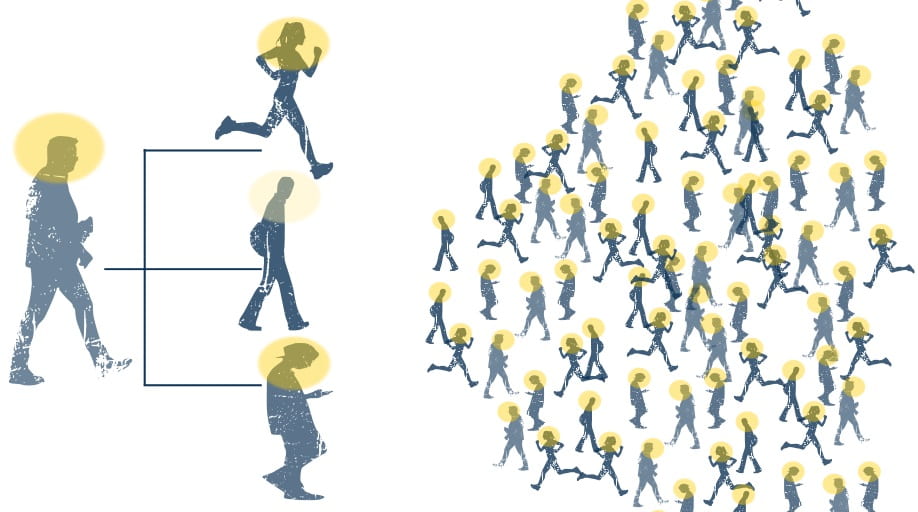
New interactive app simulates COVID-19 spread
A New Zealand-specific interactive epidemic simulation app developed by Dr Audrey Lustig, Associate Investigator at Te Pūnaha Matatini, and hosted by the University of Auckland’s Centre for eResearch, has just been released.
Called the COVID-19 Take Control simulator, the app illustrates the effects of hygiene and physical distancing measures that all Kiwis are undertaking to control the spread of COVID-19. One of the app’s key features is that it allows the user to see the effects higher and lower collective cooperation with policies aimed at breaking the chain of transmission.
Try it out now! Check out the app here.
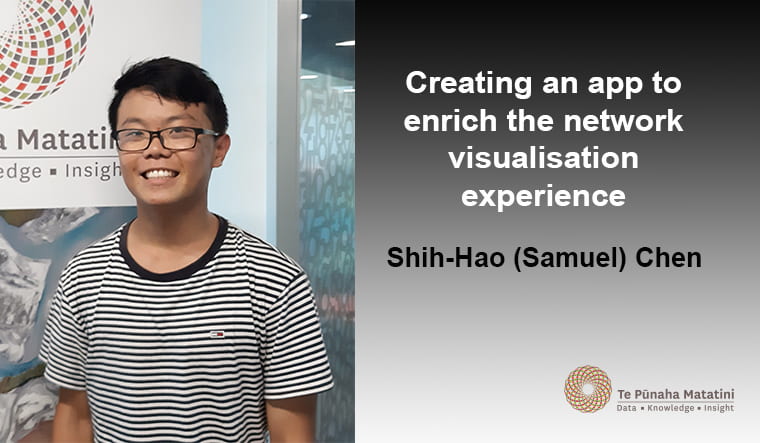
Creating an app to enrich the network visualisation experience
Te Pūnaha Matatini intern Shih-Hao (Samuel) Chen talks about his work with Nebula Data over the 2019-20 summer developing a tool that provides enhanced network analysis capabilities.
By Shih-Hao (Samuel) Chen
Networks arise in all shapes and forms in our everyday lives, and their features can provide new information to its respective topic. However, a list of nodes and edges alone is challenging to interpret, and transforming the dataset into a useful visualisation relies on inflexible third-party applications. We wanted to build a supportive, customisable tool that would enable data analysts to uncover new observations.
How does one analyse networks?
Networks are a group of nodes (things) and edges (relationships). The analysis of these networks provides answers to questions that otherwise would be difficult to answer, such as which bus stops have the most traffic, or which characters appear the most in a movie.
The question then arises – how does one analyse networks? The answer is to use a network visualisation and processing application. Gephi is a well-known application that provides this functionality, but Gephi has limitations in terms of user controllability. Our task was to produce an alternative software, but with more flexibility and control from an analytical perspective. For example, our product may offer more colouring schemes, alternative algorithms or additional forces.
When presented with a list of nodes and edges, a computer has no intuitive method of drawing the network. After all, the visualisation is purely aesthetic. The solution is to implement a force-directed algorithm that transforms the nodes into a “natural” layout. We can see the result in Figure 1:
Figure 1. Demonstration of a force-directed network in action.
The network in this visualisation is slowly untangling, allowing us to identify central nodes and clusters.
We created our application hoping for flexibility and customisation. Upon further reading, we found that the attraction/repulsion ratio between the nodes determines the resultant network shape. As shown in Figure 2 below, we can see how the visualisation algorithm can dramatise clustering by changing the forces alone.
Figure 2. Three different attraction/repulsion force ratios, and its resultant shapes.
Although these observations are informative, metrics and values help form reliable claims on these networks. By colouring the nodes based on some measure, the application presents the information in a reader-friendly way. Figure 3 below illustrates two examples of analyses that the app supports:
Figure 3. Katz (left) and Betweenness (right) Centrality, highlighted by the colouring of the nodes.
Finally, our application also provides a time-lapse feature, where we can observe how graphs change over time. The insertion/removal of nodes and edges will change the shape of the network and analysts can use these changes to make observations.
Where to next?
Although these features are incredibly useful for uncovering hidden stories of networks, there are plenty of features that could provide further insight into the relationships around us. Community detection, for example, is an exciting field that groups nodes of high connectivity together. There are also visual features, such as nodes-overlap prevention, that would improve readability.
Author
Shih-Hao (Samuel) Chen is currently studying a Bachelors of Engineering, specialising in Software Engineering. Samuel enjoys problem-solving and is incredibly fascinated with the complex nature of algorithms.

